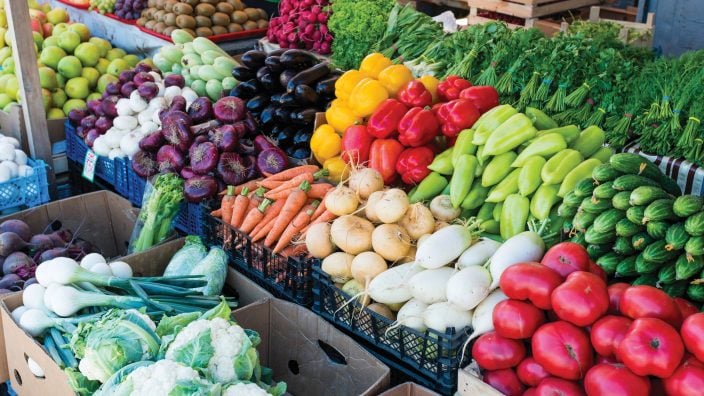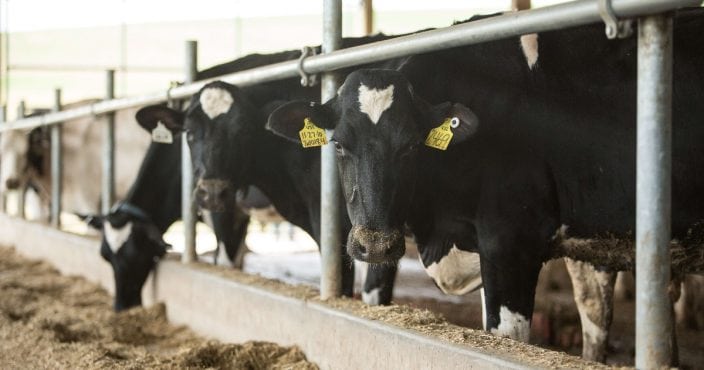Farmer’s Guide to Trucking Regulations available to Ohio Farm Bureau members
The guide includes a farm driver checklist, overview of state and federal regulations and exemptions, CDL qualifications and more.
Read More
There are still a few good dairy farms and cows in Trumbull County.
They are few and far between compared to the numbers 60 or 70 years ago. In the 1950s and ’60s, you could find small dairy farms lining the roads of the county.
Today when you travel those same roads, you find empty dairy barns — a few maintained, some beginning to fall down and the remains of some that have already fallen down.
These old dairy farms were far different from the few we find today. They were small by today’s standards with barns that housed between 15 and 40 cows plus young animals. They were mostly two stories with a small silo on the end or the side. Cows were confined to stanchions, or there were a few with tie stalls.
Milking was done mostly with machines and the milk was carried to a milk house adjacent to the barn. There it was filtered and cooled either in a cold water vat or electric coolers were beginning to be used. The milk was put in 10-gallon cans and kept until the next day when it was put out on a wooden stand by the milk house or near the road for the milk truck to pick it up and take it to the dairy plant for processing.
Today’s dairy barns are mostly one-story, free stall with the cows able to move around the barn freely. They have feed and water in front of them 24 hours a day. Stalls may be bedded with straw, sand and some have mattresses for comfort.
Milking is done in facilities called milking parlors with more automatic equipment such as auto take-offs where the vacuum teat cups fall off when the cow is done milking.
We do have in the county one dairy farm, Denmandale Farm in Johnston, where the cows are milked by robots. Fifty or 60 years ago, we would never have believed we would see cows milked automatically like they are in this herd. Robotic milkers save a lot of hand labor in milking cows but are expensive to install. Eventually, we will see a few more robots in the area.
Dairy herds left in the county are good herds or they would not be in business today. Milk prices at the farm over the past three or four years have not provided much, if any, profit for the farm family. If they were not highly efficient, they would have sold out.
Not many dairy farms in Trumbull County have gone out of business in the last two or three years. Across Ohio, there have been from 175 to 200 that sell out each year.
Farm milk prices today look somewhat better than in the past few years. Economists are not quite sure why, but say it may because production nationally has slowed down. Production is closer to demand, and that includes domestic demand and exports.
Nationally, cow numbers have dropped, but increased milk from each cow still keeps supplies high. Dairy farmers are among the most efficient farmers in the country. They have been quick to adopt new technology and are providing more comfortable housing for their animals and have made big improvements in feeding and breeding.
One concern the dairy industry has is the increase in beverages that want to call themselves milk.
They are trying to use milk’s good name to sell their product which, from a nutrition standpoint, is inferior to milk. The dairy industry wants it labeled for what it is — a drink — but not use the name milk.
Submitted by John Parker who is retired from The Ohio State University and is an independent writer for Farm Bureau and other organizations.
OFBF Mission: Working together for Ohio farmers to advance agriculture and strengthen our communities.


The guide includes a farm driver checklist, overview of state and federal regulations and exemptions, CDL qualifications and more.
Read More


The Small-Scale Food Business Guide covers federal and state regulations for selling food products such as raw meat, dairy, eggs, baked goods, cottage foods, fruits and vegetables, honey and more.
Read More

ODA will enroll 500,000 acres into the program for a two-week sign-up period, beginning April 22, 2024, through May 6, 2024. Contact local SWCD offices to apply.
Read More

Katie Share of Columbus has been named ExploreAg and Youth Development Specialist for Ohio Farm Bureau.
Read More

Mary Klopfenstein of Delphos has been named Young Ag Professional and Ag Literacy Program Specialist for Ohio Farm Bureau.
Read More

The plan has been updated to give sole proprietors access to more rate stability and a smart solution that offers potential savings on health care.
Read More

The American Farm Bureau Federation, in partnership with Farm Credit, is seeking entrepreneurs to apply online by June 15 for the 2025 Farm Bureau Ag Innovation Challenge.
Read More

Adele Flynn of Wellington has been elected treasurer of the Ohio Farm Bureau Federation and now holds the third highest elected office in Ohio’s largest and most influential farm organization.
Read More

Producers are urged to work with their veterinarian to practice enhanced biosecurity measures and review and limit cattle movements within production systems.
Read More

The changing seasons bring with them the need to thoroughly inspect pole barns for any damages that may have occurred during the winter months.
Read More